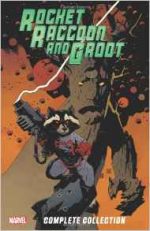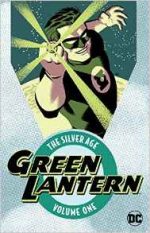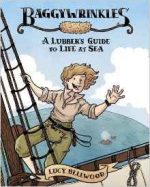
By Stan Lee, Jack Kirby, Bill Mantlo, Dan Abnett & Andy Lanning, Keith Giffen, Mike Mignola, Timothy Green II & various (Marvel)
ISBN: 978-0-7851-6713-6
Although heralded since its genesis in the early 1960s with making superheroes more realistic, The House of Ideas has also always maintained its close connection with outlandish and outrageous cosmic calamity (as seen in their pre-superhero “monster-mag†days), and their pantheon of much-travelled space stalwarts maintain that delightful “Anything Goes†attitude in all of their many and varied iterations.
The pair of interstellar oddments featured here are creative oddments who took a very long time to achieve their stellar potential and have done particularly well out of recent reboots and re-imaginings: both in comicbooks and through large and small screen reinterpretations…
Collecting Groot’s debut from Tales to Astonish #13; Incredible Hulk # 271, Rocket Raccoon volume 1 #1-4, and pertinent material from Marvel Preview #7, Annihilators #1-4 and Annihilators: Earthfall #1-4, collectively ranging from November 1960 to February 2012, this fun-filled paperback compendium offers a wealth of thrills and expansive action and a fair slice of witty satire to boot…
The sidereal shenanigans begin with an absolute classic of the gloriously whacky “Kirby Kritter†genre, predating the birth of the Marvel Age. Crafted by Stan Lee, Larry Lieber, Kirby & Dick Ayers, ‘I Challenged Groot! The Monster from Planet X’ (Tales to Astonish #13, November/December 1960) reveals how a studious biologist saves humanity from a rapacious walking tree intent on stealing Earth cities and shipping them back to his distant world.
Rocket Raccoon was a minor character who first appeared in backup serial ‘The Sword in the Star’. His debut was in Marvel Preview #7 in 1976 but that particular tale comes later.
In 1982, writer Bill Mantlo brought him into the mainstream of the Marvel Universe with a star role in Incredible Hulk #271 (May). Like Wolverine years before, the hairy iconoclast then simply refused to go away quietly…
Illustrated by Sal Buscema, ‘Now Somewhere In the Black Holes of Sirius Major There Lived a Young Boy Name of… Rocket Raccoon!’ found the jade juggernaut stranded on an alien world where sentient animals used super-scientific gadgetry to battle robot clowns to preserve the security of humans who seemed incapable of caring for themselves. When Green-skin arrived, a simmering civil war broke out…
With the Hulk safely removed from the combat zone, Rocket faded from view for a few years before returning in a newfangled format for comicbooks: a mini series…
The 4-issue Rocket Raccoon miniseries (cover-dated May to August 1985 and crafted by Mantlo, Mike Mignola, Al Gordon & Al Milgrom) presented a bizarre and baroque sci-fi fantasy blending the charm of Pogo with the biting social satire of One Flew Over the Cuckoo’s Nest all whilst ostensibly describing a battle between Good and Evil in a sector of space crazy even by funnybook standards.
Rocket was one of many talking animals in the impenetrable, inescapable Keystone Quadrant; a Ranger in charge of keeping the peace in a troubled atmosphere where robots and anamorphic beasties went about their ordained task of caring for the distinctly odd and carefree humans known as The Loonies on their idyllic, sybaritic planet Halfworld.
When a brutal shooting war between voracious apex toymakers Judson Jakes and Lord Dyvyne leads to Rocket’s girlfriend Lylla Otter being kidnapped, the planet goes crazy wild, or perhaps… ‘Animal Crackers’.
In rescuing her, Rocket and faithful deputy Wal Rus have to contend with a murderous army of mechanised Killer Clowns, face an horrific, all-consuming bio-weapon at ‘The Masque of the Red Breath’, and even team up with arch-foe and disreputable mercenary bunny Blackjack O’Hare in ‘The Book of Revelations!’ before finally uncovering the horrendous truth behind the mad society they so unquestioningly defend…
The final chapter shakes everything up as ‘The Age of Enlightenment’ sees the end of The Loonies, allowing the Raccoon and his surviving companions to escape the confines of the eternally segregated Keystone Quadrant into the greater universe beyond…
Next – eschewing continuity but at least presented here in the original monochrome – is that first Rocket romp from Marvel Preview #7.
‘The Sword in the Star’ was an epic combination of Druillet’s Loan Sloane stories with Homer’s Odyssey and Virgil’s Aeneid, detailing the interstellar search by Prince Wayfinder of Ithacon to find a new home for his dying people. That exodus took them from 1500 years in Earth’s future to prehistory where, on their second stop, the Once and Future King landed on a ‘Witch World!’ where trees tried to kill the imperial exile and a sarcastic, heavily-armed rodent helped him confront a sinister sorceress dubbed Kirke…
Impressively rendered by Keith Giffen in full Euro-mode, the story ended on a cliffhanger you won’t see resolved here…
In 2006 a massive crossover involved most of Marvel’s 21st century space specialists in a spectacular Annihilation Event, leading writing team Dan Abnett & Andy Lanning to confiscate and reconfigure the Guardians of the Galaxy concept for modern times and tastes.
Among the stalwarts in the big event were Silver Surfer, Galactus, Firelord (and other previous heralds of the world-eater), Moondragon, Quasar, Star-Lord, Thanos, Super–Skrull, Rigellian Colonizer Tana Nile, Gamora (“Deadliest Woman in the Galaxyâ€), Ronan the Accuser, Nova, Drax the Destroyer, a Watcher and many previously established alien civilisations such as the Kree, Skrulls, Xandarians, Shi’ar et al., all falling before an invasion of rapacious Negative Zone bugs and beasties unleashed by insectoid horror Annihilus..
After that shooting match subsided the decimated sectors and empires were left helpless as all-subsuming technological parasite The Phalanx struck, absorbing and thriving inside the machines and electronic engines the shaken civilisations were using to rebuild in a follow-up apocalypse designated Annihilation: Conquest.
To counter the threat Star-Lord Peter Quill was tasked with turning a bunch of Kree convicts into a Penal Strike Force (a highly engaging intergalactic Dirty Half-Dozen): Galactic Warrior Bug (originally from 1970’s phenomenon Micronauts), then-current Captain Universe, Shi’ar berserker Deathcry, failed Celestial Madonna Mantis, Groot and a so-very-far-from-home Rocket Raccoon…
From those sidereal sagas came a new Guardians of the Galaxy plus a pack of Cosmic Crusaders known as Annihilators. Their first 4-issue miniseries spanned May to August 2011 and carried a back-up strip starring Rocket and Groot by Abnett, Lanning and Timothy Green II.
After the wars, not all the heroes were feted – or even remembered – and Rocket is forced to take a job in the mail room of intergalactic corporation ‘Timely Inc’. He loathes the entire experience but when somebody sends a Killer Clown after him soon slips into old habits and goes looking for guns, grenades and answers…
He doesn’t find them on Planet X when seeking out Groot, but does save his old pal from certain death in ‘There is Unrest in the Forest, There is Trouble with the Trees’…
When Groot speaks of events Rocket can’t remember, the little warrior realises his mind has been tampered with and the trail leads right back to Halfworld…
The place has completely changed. ‘It’s a Mad Mad Mad Mad World’ now, containing the most dangerous mind in creation, and once Rocket discovers who excised his memories and why, it’s only a little leap of imagination to realise he’s been drawn into a subtle snare with potentially catastrophic consequences…
Armed with knowledge – and heavy ordnance – he and Groot then shut down the manipulator and save the universe through a carefully applied ‘Brain Storm’…
In November 2011 Annihilators: Earthfall offered another 4-issue miniseries with Abnett, Lanning & Green reprising Rocket and Groot’s danger-magnet escapades at the back of each. In ‘Batteries Not Included’ our unlikely heroes find themselves in one perilous situation after another with no idea of how they got there.
Only gradually do they realise they’ve been kidnapped by insidious impresario Mojo: turned into unwilling showmen and merchandising franchise with the prospect of painful death arising at every moment.
Understandably unhappy, they renegotiate terms in the most destructive manner possible…
This razor-sharp, spectacular slice of riotous star-roving action is a non-stop feast of tense suspense, surreal fun and blockbuster action: well-tailored, on-target and certain to turn curious movie-goers into fans of the comics incarnation.
© 2013 Marvel Characters Inc. All rights reserved.










